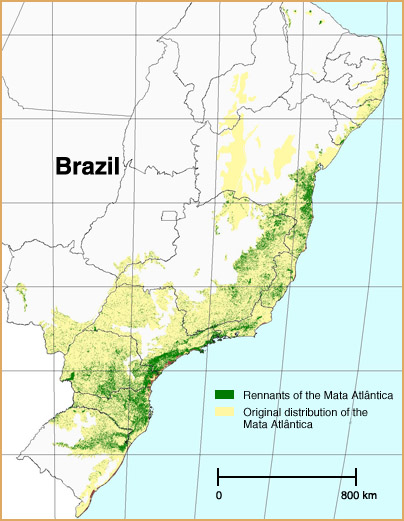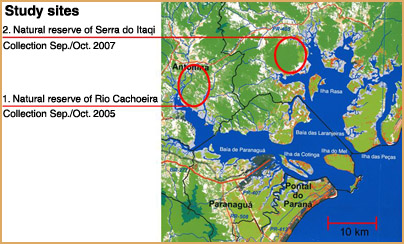The Mata Atlântica is one of the most threatened forest ecosystems in the world, 91-93 % of the original forest cover is destroyed. The portion of the primary forests is fragmented and is still decreasing.

Mata Atlântica
Despite of its high degree of degradation the portion of endemism and the diversity is still very high. Hence one can describe the Mata Atlântica as a “hotspot of biodiversity”.
These forests still provide various ecosystem services for the local population and for mankind in general. (e.g. preservation of fertile soil, protection against erosion, climatic stabilisation, groundwater reserve, etc.). Because the primary forests are mostly destroyed the focus of preservation efforts and research surveys should be directed also on the secondary forests, which nowadays make up the biggest part of the forest cover.
Willis et al. (2004) surveyed the potential of secondary forests for preservation of biodiversity as an alternative habitat for the primary forest dwelling species, but so far only few studies about the potential of secondary forests as biodiversity reserves have been realized.
Our study areas are located in the two private forest reserves of the Society of Wildlife Research and Environmental Education (SPVS) – Reserva natural do Rio Cachoeira and Reserva natural da Serra do Itaqui.

Study Area
We accomplished two collections, in September 2005 in Cachoeira and in September 2007 in Itaqui.
In both study areas we followed the same study design:
We established 12 study plots with 30 x 50 m each, i.e. 4 different forest succession (Table 1) stages with 3 independent, spatially separated replicates. They were all established on Cambisol soil areas. Each series of forest stages comprises the following stages (Table below): herbaceous (H: youngest stage, 5-7 years old), arboreal (A, 12-18 years), Median advanced (M, 35-50 years), and Old Growth forest (F, >100 years).
Sampling design and forest stages
|
Stage H Herbaceous |
Stage A Arboreal |
Stage M Median |
Stage F Old growth |
|
| Age (Years) | 5-7 | 12-15 | 35-50 | >100 |
| Cachoeira | 3 | 3 | 3 | 3 |
| Itaqui | 3 | 3 | 3 | 3 |